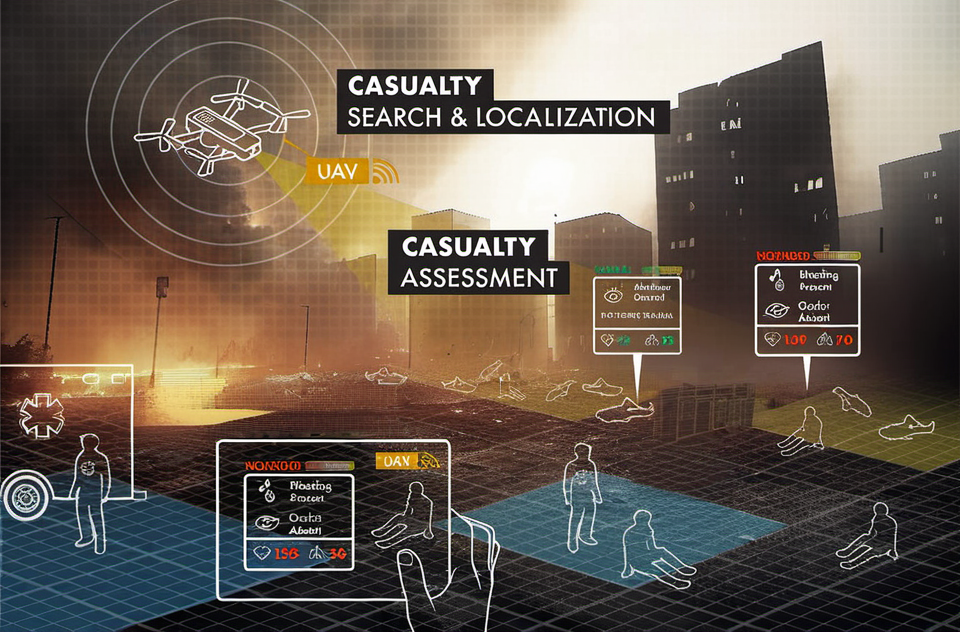When disaster strikes, it rarely ever affects a single person. Mass casualty events, where the victims outnumber the first responders, have become increasingly common. Whether it’s a plane crash, a train wreck, or the aftermath of a building collapse, the number of victims and places to search quickly overwhelm the small contingent of first responders.

Time is critical, as the golden hour, the critical time needed to get a patient to the hospital following a traumatic injury not only rapidly depletes, but also varies from person to person. The status quo, where rescuers have to triage with incomplete information and incomplete resources, has, and will, continue to cost lives. Changing the triaging paradigm is the first step toward saving more lives.
The Challenge
The DARPA Triage Challenge is DARPA’s initiative toward developing autonomous systems that can aid rescuers in this specific realm. Going beyond traditional search and rescue, specialized disaster unmanned vehicles will perform triaging as well – designating the people that need critical care the fastest, allowing rescuers to prioritize life-saving treatment and allocate resources effectively.
Autonomous vehicles in the challenge perform localized mapping, search, and triage functions, delivering to rescuers timely reports of where victims are, and which victims to prioritize for immediate medical care, alongside biometric information that shortens diagnostic time, allowing rescuers to start life-saving action immediately.
The Next Disaster
For decades, speculation on the next major earthquake to hit California has raised preparation standards in the state to the highest – but no matter the degree of preparation, catastrophe is the expectation. When the Big One hits, our solution, the Broad Area Support for Triage and Identification Drone, or BASTI, for short, will deploy alongside the first wave of responders. Flying ahead of the first feet on the ground, it’ll map out the scene – buildings collapsed, rubble lining the streets, fire hazards, cars blocking the road, steep slopes and splits on the ground. This information informs rescuers, and the following drones, of the viable safe paths remaining, and more importantly, the critical routes needed to reach victims before time runs out.

BASTI then flies over to identify victims – either those fully visible, emerging from hiding spots, or those patiently occluded, trapped or pinned under a piece of rubble. BASTI then tracks and localizes the victims, providing unique identification that gives rescuers key information on the number of victims within the area, and if they need immediate help, their exact GPS location. In tandem with other drones, BASTI’s overflight provides key information that rescuers on the ground otherwise would have to spend a hour searching for – an hour that they don’t have.
Following it’s search protocol, BASTI begins to triage patients that ground robots are unable to reach in time. With a suite of powerful sensors and a camera array on its underside, BASTI hovers closely to a trapped victim, performing an automated assessment battery that provides key biometric data, transmitting it to a central station that can coordinate rescue operations. In this case, BASTI is able to ascertain that the patient has suffered severe blood loss, and needs immediate evacuation. Rescuers are able to be quickly tasked, and prioritize making their way toward that patient. Meanwhile, BASTI continues to go between patients, providing updated triaging data that allows other rescuers to track other patients, prioritize life-saving treatment, and focus evacuation efforts.
Thanks to BASTI, before night falls, many patients make it to the hospital, where the top trauma surgeons in the country are able to receive them well within the golden hour. While earthquake recovery efforts continue, the work done by these unmanned systems have significantly augmented an otherwise critically resource-short emergency response effort. As night falls, BASTI is packed up within minutes and loaded onto a truck heading across the county, ready to continue it’s critical work at a moment’s notice.